使用自定义返回类型从数据库获取数据的常用方法,数据访问层C#
在我的数据访问层中,我有一个名为Execute的类。 class Execute用于与数据库进行事务。
我有另一个名为Table1DataAceess的类与Execute类进行通信,BusinessLogicClass1与数据访问层进行通信。例如:图片

我只有4种方法与数据库进行任何交易(插入,更新,删除,检索)。 在Retrieving方法中,我想实现获取任何返回类型而不预先定义返回类型。
例如:如果我想获取一个VehicleModel数据列表,在我的Table1DataAceess类中,我只需要编写
Execute DBExe = new Execute();
List<VehicleModel> vList = DBExe<List<VehicleModel>,VehicleModel>(spName,model);
//If I wanna take it into a DataTable
DataTable dt = DBExe<DataTable,VehicleModel>(spName,model);
我开发了以下方法,
public T SpExecutesNew<T,T1>(string cmdText, T1 item) where T : new()
{
DataSet ds = new DataSet();
SqlDataAdapter ad = new SqlDataAdapter();
SqlCmd = new SqlCommand();
SqlConnection conn = null;
try
{
conn = clsConnection.OpenConnectiion();
SqlCmd.Connection = conn;
SqlCmd.CommandText = cmdText;
SqlCmd.CommandType = CommandType.StoredProcedure;
SqlCmd.CommandTimeout = 100;
PropertyInfo[] Props = typeof(T).GetProperties(BindingFlags.Public | BindingFlags.Instance);
SqlCommandBuilder.DeriveParameters(SqlCmd);
foreach (SqlParameter prr in SqlCmd.Parameters)
{
bool found = false;
if (prr.ParameterName.ToUpper() == "@RETURN_VALUE")
continue;
for (int i = 0; i < Props.Length && !found; i++)
{
string prName = "@" + Props[i].Name;
if (prr.ParameterName == prName)
{
prr.Value = Props[i].GetValue(item, null);
found = true;
}
}
}
ad = new SqlDataAdapter(SqlCmd);
ad.Fill(ds);
//List<T> list = new List<T>();
///STIL IMPLIMENTING...
////return (T)Convert.ChangeType(ds.Tables[0], typeof(T));
}
catch (Exception ex)
{
throw ex;
}
finally
{
if (conn != null && conn.State == ConnectionState.Open)
conn.Close();
if (conn != null)
conn.Dispose();
SqlCmd = null;
}
}
我不知道如何使用数据创建此返回类型“T”。因为如果它是一个列表,那么我必须填写列表并返回列表。 (方法应该将T作为列表返回)但是如何将列表创建为T。
请帮助..
1 个答案:
答案 0 :(得分:2)
这是一个例子
这是DbAccess图层的方法。这个方法将执行readader,你甚至可以填充数据表并将其转换为列表。
public List<T> ReturnList<T>(CommandType commandType, string commandText, List<SqlParameter> parameters) where T : new()
{
SqlDataReader reader = null;
try
{
CreateConnection();
command = new SqlCommand();
BuildCommand(command, commandType, commandText, conn);
AddParametersToCommand(parameters, command);
reader = command.ExecuteReader();
List<T> list = CommonMethods.ToList<T>(reader);
reader.Close();
reader.Dispose();
CloseConnection();
return list;
}
catch (Exception ex)
{
reader.Close();
reader.Dispose();
conn.Close();
throw ex;
}
finally
{
}
}
这是将数据表或sqldatareader转换为任何给定类列表的代码
CommonMethods.Cs
public static class CommonMethods
{
public static List<T> ToList<T>(DataTable datatable) where T : new()
{
List<T> Temp = new List<T>();
try
{
List<string> columnsNames = new List<string>();
foreach (DataColumn DataColumn in datatable.Columns)
columnsNames.Add(DataColumn.ColumnName);
Temp = datatable.AsEnumerable().ToList().ConvertAll<T>(row => getObject<T>(row, columnsNames));
return Temp;
}
catch { return Temp; }
}
private static T getObject<T>(DataRow row, List<string> columnsName) where T : new()
{
T obj = new T();
try
{
string columnname = "";
string value = "";
PropertyInfo[] Properties; Properties = typeof(T).GetProperties();
foreach (PropertyInfo objProperty in Properties)
{
columnname = columnsName.Find(name => name.ToLower() == objProperty.Name.ToLower());
if (!string.IsNullOrEmpty(columnname))
{
value = row[columnname].ToString();
if (!string.IsNullOrEmpty(value))
{
if (Nullable.GetUnderlyingType(objProperty.PropertyType) != null)
{
value = row[columnname].ToString().Replace("$", "").Replace(",", "");
objProperty.SetValue(obj, Convert.ChangeType(value, Type.GetType(Nullable.GetUnderlyingType(objProperty.PropertyType).ToString())), null);
}
else
{
value = row[columnname].ToString().Replace("%", "");
objProperty.SetValue(obj, Convert.ChangeType(value, Type.GetType(objProperty.PropertyType.ToString())), null);
}
}
}
} return obj;
}
catch { return obj; }
}
public static List<T> ToList<T>(SqlDataReader dataReader) where T : new()
{
List<T> res = new List<T>();
while (dataReader.Read())
{
T t = new T();
for (int inc = 0; inc < dataReader.FieldCount; inc++)
{
Type type = t.GetType();
PropertyInfo prop = type.GetProperty(dataReader.GetName(inc));
prop.SetValue(t, dataReader.GetValue(inc), null);
}
res.Add(t);
}
return res;
}
}
以下是您将如何称呼它
List<YourClassName> list = DbAccess.ReturnList<YourClassName>(System.Data.CommandType.StoredProcedure, "searchappointments", listParams);
相关问题
最新问题
- 我写了这段代码,但我无法理解我的错误
- 我无法从一个代码实例的列表中删除 None 值,但我可以在另一个实例中。为什么它适用于一个细分市场而不适用于另一个细分市场?
- 是否有可能使 loadstring 不可能等于打印?卢阿
- java中的random.expovariate()
- Appscript 通过会议在 Google 日历中发送电子邮件和创建活动
- 为什么我的 Onclick 箭头功能在 React 中不起作用?
- 在此代码中是否有使用“this”的替代方法?
- 在 SQL Server 和 PostgreSQL 上查询,我如何从第一个表获得第二个表的可视化
- 每千个数字得到
- 更新了城市边界 KML 文件的来源?